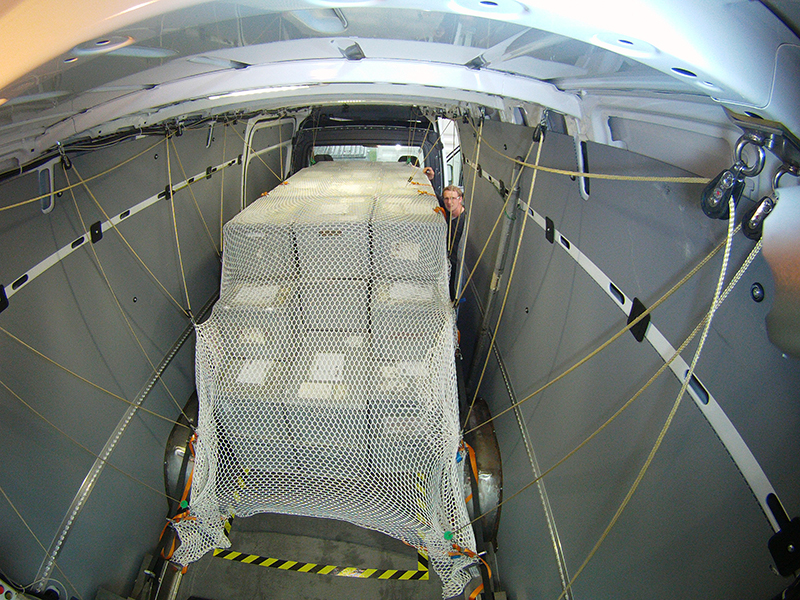Load securing at the push of a button
Saxon enterprises and research institutes in the fields of logistics, materials handling and textile industry developed an automated load securing system for parcel services
-

A flexibly adaptive grid spans the cargo that can be lifted over retraction ropes and guide rollers within a few seconds under the load compartment cover, as soon as the driver wishes to unload the van. Photo: Andreas Fink
Every day, parcel and courier services transport goods from A to B. This must be done on time and be reliable. The load’s and the driver’s safety plays a particularly important role. The packages must not slip around while cornering and braking an even when opening the door of the carrier the packages have to be fixed. Such lashing means like nets or straps help to protect the driver and cargo. “However, especially for courier express parcel services with many stops currently available, security solutions are too time-consuming. We have tested in nearly 15-year experience as a courier express service different load securing means, but none of them was able to convince our drivers properly“, says Sebastian Fankhänel, the Managing Director of ECL euro.COURIER Logistics GmbH in Chemnitz. “According to a directive of loads on road vehicles, the load must be secured ‘ahead‘ , ‘sideways‘ and ‘backwards’. In practice, many services pile up the goods positive-locking to the separation and side walls, what only partially meets the requirements“, estimates Prof. Dr. Klaus Nendel, head of the Professorship of Materials Handling and Conveying Engineering at Technische Universität Chemnitz.
In Saxony, a network of enterprises and research institutions in the fields of logistics, materials handling and textile industry holistically tackled the issue of load securing. The Professorship of Materials Handling and Conveying Engineering at TU Chemnitz, the Saxon Textile Research Institute (STFI) in Chemnitz and the companies F.J.RAMMER GmbH in Ohorn, car-management GmbH in Delitzsch and ECL euro.COURIER Logistics GmbH in Chemnitz developed an effective and above all easy-to-use automated load securing system for drivers within two years. The project was funded with 550.000 € by the German Federation of Industrial Research Associations ”Otto von Guericke“ e.V. (AiF – ZIM project).
“Two main components essentially contribute to the secure loading. Firstly, there is a non slip system, which exploits the advantages of a low-friction surface at the time for loading and a slip resistant effect of an adhesive pad during transport. Secondly, there is a flexibly adaptive net which lashes different-sized transport units“, explains Nendel. The load securing system may be operated from a capacity of 1.2 up to 6 cubic meters.
The load securing net consists of high-strength material with integrated net shortener. The project manager Andreas Fink explains an ease of operation: ”The driver only needs to stack in a selected area its cargo. By pushing a button, two lashing systems unwind the loading straps that pull down the cargo net from the ceiling of the transporter, pull the cargo and tension it. This process needs 15 seconds. In order to unload, the cargo net is lifted below the ceiling by pushing the button as well. This function is carried out by two haulback lines, which are led by snatch blocks in net and at cargo’s roof bows. Currently, the lashing system unwinds the lines in a maximum of 25 seconds.“
Initial experiments showed that the system can secure a payload up to 500 kilograms. ”When loading up the crates and boxes on standard non-slip mats is complicated to handle“, estimates Nendel. For this reason inventors from Saxony have introduced lowerable sliding rails between anti-slip strips. These are connected underneath with a synthetic rubber having a specific time-dependent pressure-deformative behavior. ”This means, the cargo can easily be moved on the floor during loading. Under the weight of stacked boxes, the sliding rails are lowered and the boxes rest fully on the adherent coating during transport“, assures Fink.
The analysis of data from a three-week field trial in a van with drivers of ECL euro.COURIER showed that the newly developed load securing system was used exclusively in 75 percent of the trips, where lashing means has been used. On the other side, loading straps were only used in 19 percent of cases. In six percent of the cases the load securing system and a conventional lashing means like load straps were used in combination. The average transport volume was 2.9 cubic meters per trip during the field trial. ”Of course, there is still need for improvement up to readiness for a series production“, emphasises Nendel and adds: ”Bearing in mind that the number of parcel services is increasing and there will be state controls of delivery services in the future, the use of automated cargo securing system is difficult to avoid.“
Presentation of research results: https://www.tu-chemnitz.de/mb/FoerdTech/fsl/fsl_projekte.php#tab2
For more information, please contact Prof. Dr. Klaus Nendel, Phone +49 371 531-32323, Email klaus.nendel@mb.tu-chemnitz.de
(Author: Mario Steinebach, Translation: Nataliia Boiko)
Mario Steinebach
24.11.2014




